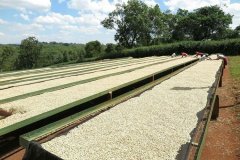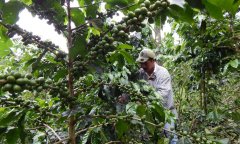Taste of Honduran Coffee beans present situation and brief History of Coffee in Honduras-Coffee mini file

For professional baristas, please follow the coffee workshop (Wechat official account cafe_style)
Honduras Honduras
Many people don't know that the coffee production in Honduras is amazing.
After 2011, Honduras has overtaken Guatemala to become the seventh largest coffee producer in the world (Guatemala 10th)
Ahead of it are all coffee countries, including Brazil, Vietnam, Indonesia, Colombia, India and so on.
Honduras is not only the largest coffee producer in Central America, but also the second largest in the world if only washed Arabica beans are counted.
It was not until the end of the last century and the beginning of the 21 century that coffee surpassed bananas to become the most important cash crop.
Banana production is dominated by large American companies, but coffee growers are all small farmers.
There are an estimated 110000 coffee farmers in Honduras, and picking cherries by hand is the main method of harvest.
Coffee can create 1 million jobs during the harvest season, which is a good opportunity for young people to earn extra money.
The school is closed from November and doesn't start until early February, which is the coffee harvest season.
In recent years, the quality of Honduran coffee has been gradually recognized by the international market.
Excellent varieties such as Bourbon, Catuari, Kaddura, Caturra and Typica Pacas Pacas
Grow in different areas and develop different flavors.
Since 2007, Honduras has strengthened its origin labelling system, dividing coffee producing areas into six major brands:
Class (Copan)
Opalaca
Montecillos
Comayagua
Agalta
Paraiso
A brief history of coffee in Honduras:
The coffee industry in Honduras has developed quite late, far less than most of the neighboring countries in Central America.
In 1970, the government created the official body Instituto Hondure ñ o del Cafe (IHCAFE).
Committed to improving the quality of coffee, and in the six producing areas identified by the agency
Set up coffee laboratories to assist coffee producers.
Coffee production increased greatly after 2001, until 2011, coffee production reached nearly 6 million bags.
The number exceeds that of Costa Rica and Guatemala combined, with about 110000 households engaged in coffee production.
Since 2012, production has fallen sharply due to leaf rust (Roya).
Leaf rust (Roya) is a fungus of coffee camel rust (Hemileia Vastatrix).
So that the leaves are not enough for self-photosynthesis and fall, eventually killing the whole tree.
The warming of climate change has worsened leaf rust and extremely high rainfall.
Making it difficult to dry and preserve coffee is a major issue facing Honduras today.
Honduran Coffee Mini File:
The main varieties are Arabica, including Kaddura, Kaduai, Pacas and Tibica.
The main method of treatment is washing. Is the fifth largest coffee producer in the world.
And is about to be promoted to the fourth largest coffee producer in the world!
The global market share is about 3%.
Altitude rating in Honduras:
Strictly High Grown (SHG): over 1200 meters.
High Grown (HG): over 1000 meters.
Central Standard (CS): planted more than 600m above sea level.
Honduran coffee features:
There are three main producing areas in Honduras, which produce more than half of the country's total coffee.
Montesius (Montecillos): the highest elevation manor in Hongguo, the coffee is bright and rich, with citrus aromas.
Copan province (Copan): Copan beans all chocolate flavor, mellow taste, and high sweetness.
Agalta: coffee beans in this area have tropical fruit aromas, sweet taste, balanced acidity and chocolate flavors.
Generally speaking, Hongguo's coffee is gorgeous and fruity, and tastes like fruit juice, sometimes with the aroma of nuts and taffy.
Important Notice :
前街咖啡 FrontStreet Coffee has moved to new addredd:
FrontStreet Coffee Address: 315,Donghua East Road,GuangZhou
Tel:020 38364473
- Prev

Tanzania-Luwaita Cooperative Cooperative introduces baking advice
For the exchange of professional baristas, please follow the coffee workshop (Wechat official account cafe_style) Tanzania-Luwaita Cooperative cooperative East Africa is the producer of many fine coffee, including Kenya, Ethiopia, Rwanda, etc. Tanzania is another country that produces good coffee in East Africa. Tanzania is located in East Africa and borders India with seven countries.
- Next

Honduras Coffee production area Manor Makala Manor Manor Honduras Coffee copan
For professional baristas, please follow the Coffee Workshop (official Wechat account cafe_style) Sweet Orange Manor (El Naranjo) is located in Marcala, one of the most famous producing areas in Honduras. Last year, in 2016, Sweet Orange won 14th place in the Outstanding Cup Competition. Female owner Carmen Fabiola Fiallos Melendez finally realized that he became a boutique coffee.
Related
- Does Rose Summer choose Blue, Green or Red? Detailed explanation of Rose Summer Coffee plots and Classification in Panamanian Jade Manor
- What is the difference between the origin, producing area, processing plant, cooperative and manor of coffee beans?
- How fine does the espresso powder fit? how to grind the espresso?
- Sca coffee roasting degree color card coffee roasting degree 8 roasting color values what do you mean?
- The practice of lattes: how to make lattes at home
- Introduction to Indonesian Fine Coffee beans-- Java Coffee producing area of Indonesian Arabica Coffee
- How much will the flavor of light and medium roasted rose summer be expressed? What baking level is rose summer suitable for?
- Introduction to the characteristics of washing, sun-drying or wet-planing coffee commonly used in Mantenin, Indonesia
- Price characteristics of Arabica Coffee Bean Starbucks introduction to Manning Coffee Bean Taste producing area Variety Manor
- What is the authentic Yega flavor? What are the flavor characteristics of the really excellent Yejasuffi coffee beans?

